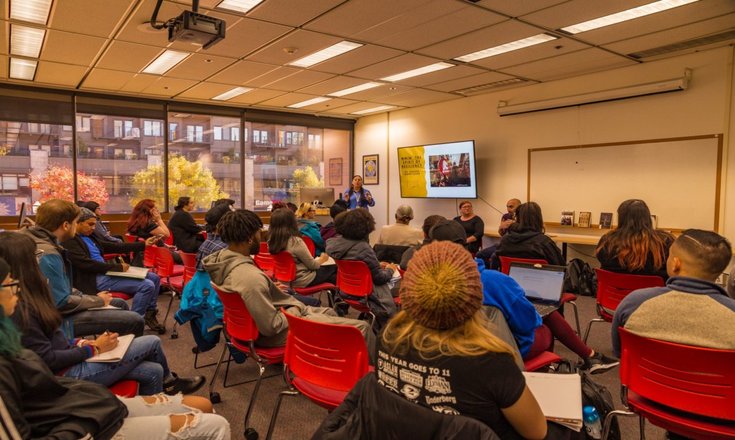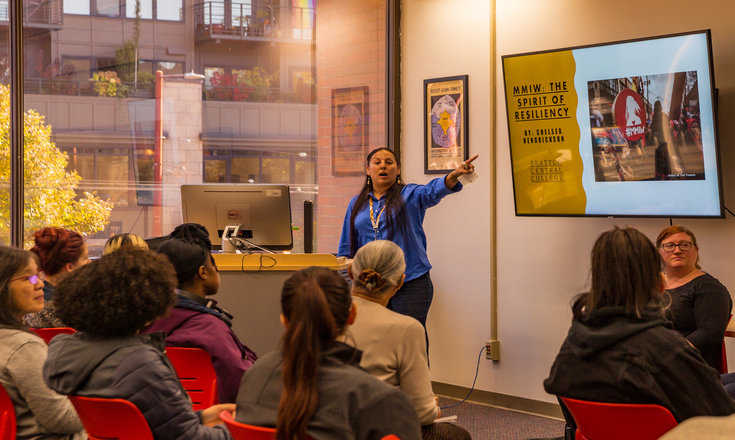The most recent COSI event on Thursday, October 10th, welcomed Chelsea Hendrickson (an enrolled member of the Northern Arapaho and Cup’iq people) as well as several guest speakers to lead the discussion on the epidemic of Missing and Murdered Indigenous Women (MMIW) in Canada and the US. Awareness of the epidemic, which affects Native communities both on reservations and in Urban Native communities (Seattle being the city with the highest figure in the US), is the result of document requests, data collection and reports from Native community leaders Hendrickson, Abigail Ecko-Hawk (Pawnee of Oklahoma), and Annita Lucchesi (Southern Cheyenne).
According to a survey conducted in 2010, 94 percent of American Indian or Alaska Native-identified women (of the 148 interviewed) reported either being raped or coerced into sex. In June of 2016, Washignton passed a bill which requires the Washington State Patrol to compile date and analysis of murdered and missing Indigenous women and girls. The new report is based on records from 71 U.S. cities and identifies 506 cases of missing or murdered indigenous women and girls dating back to 1943. These figures are considered an undercount.
According to one of the three series of reports from Our Bodies our Stories released by the Urban Indian Health Institute (“a series of reports that details the scope of violence against Native women across the nation”), research finds multiple challenges impacting data collection on the actual number of missing or murdered American Indians and Alaska Natives living in areas off reservations and villages. Abigail Echo-Hawk, director of UIHI, points out, “Seventy-one percent of American Indian and Alaska Natives live in urban areas, yet accurate data does not exist regarding the rate of violence among this population.”
Hendrickson explained the lack of accuracy in data being the result of several key factors, the most evident of which being that the lives of American Indian and Alaskan people (women and girls in particular in the context of this epidemic) are severely devalued. This historical devaluation of the lives of Indigenous people in the US and Canada, has roots in systemic racism and contributes to the injustices and atrocities perpetrated by both the U.S. and Canadian governments. Disregard for treaty rights, racial misclassification of missing and murdered Indigenous people as white, and the tearing apart of families by way of forcing American Indian children into BIA-run boarding schools for the purpose of cultural and religious assimilation into White culture (“Kill the Indian, save the man”) are also intersecting factors which perpetuate the oppression and shortening of Native lives. Out of all the racial groups, Native people are killed at a higher rate than any other in the U.S. or Canada.

Our Bodies Our Stories (which Echo-Hawk funded from her own speaking engagements due to lack of funding), are examples of Native women speaking out about past generational trauma.
The background story of this project is that, like other issues facing the Native communities, people have always been aware of the violence that Native women and girls experience. The fact that people refuse to care or acknowledge it, and that there has been no outcry in addition to the lack of adequate reporting, led to the creation of Our Bodies Our Stories.
“We have always known that violence against Native women was an issue, but people refuse to acknowledge it”, Echo-hawk states in the report. “We are showing that data is going to be important to bringing change and that more research is urgently needed to protect our women and girls.” Hendrickson informs the discussion attendees, “We are taking back the narrative.”
In addition, traditional long-established community-centered solutions within American Indian and Alaska Native nations (such as her own Northern Arapaho culture in the form of councils lead by respected elders for example) are a part of the organized structures which enforced the sense of accountability when local moral or ethical laws were broken by someone in the community. Hendrickson emphasized that empowerment and self-determination is key. The result is the current movement of Native people having autonomy and pride in the traditions and customs which have been intentionally and historically erased by the dominant culture.
During the last portion of the event, Hendrickson provided a wealth of resources on organizations and services led by Indigenous leaders doing various levels of work to serve the urban Native community in Seattle, as well as some helpful advice to allies who wish to help. Support in the way of donations to organizations such as The Urban Indian Health Institute, United Indians of All Tribes Foundation’s Our Strong Fathers Support Program, and their Labeteyah Youth Home were emphasized as examples of where helpers can start in order to support Urban Native families.
“The best way to help is to put your money where your mouth is. I don’t ever expect people of color to bear the burden of monetary support, especially my Black and Latinx people…but I do expect our white allies to.”







Be First to Comment